#Fashion essays
Text
Just realized I can post this. Please watch the ones about social issues omg
#The Harry Potter Ones Are About How Much It Sucks And The “Can You Tell If A Disabled Person Is Faking” One Is About How Bad Fake Claiming I#The Owl House#Neurodivergent Essays#Gravity Falls#Queer Essays#Racism Essays#Fandom Essays#wandavision#Musical essays#Disability essays#Hamilton#Six#Music essays#Cats#Leftist essays#Fashion essays#Warrior cats essays#Cartoon essays#Janus’s Corner
3 notes
·
View notes
Text


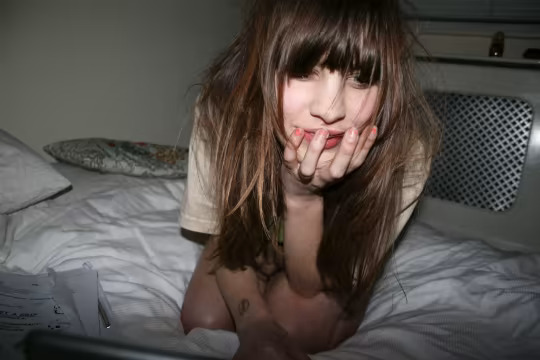
Alexa Chung on the unpolished appeal of Indie Sleaze for Financial Times Fashion (2023)
#archive#alexa chung#the financial times#financial times fashion#indie sleaze#2023#essay#cobra snake
3K notes
·
View notes
Text
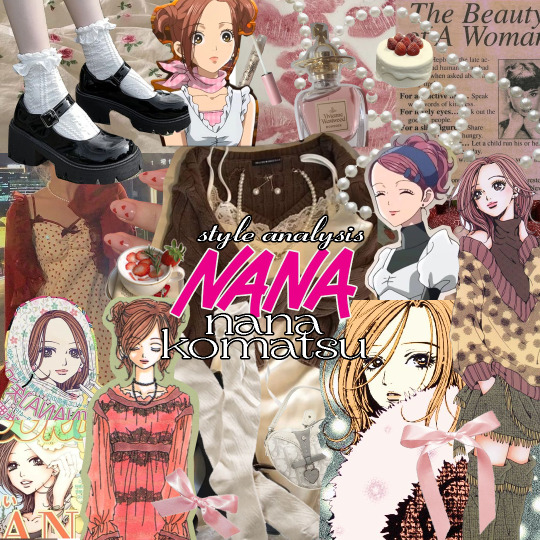
🍓 style analysis: nana komatsu / hachi (NANA)
welcome to the first entry in my style analysis series- where i take a different fictional character for each entry and take a look at their fashion sense, as an exploration on how fashion plays a role in forming a character's personality & overall identity. in other words, it's a deep dive into the intersection of story & style. today we're starting off with nana komatsu (who we'll be affectionately referring to as hachi from here on out) from NANA, my favourite character from my favourite manga of all time.
NANA is a manga very near and dear to my heart. i could spend all day talking about why, but i'd say one of the biggest reasons is for how ai yazawa (the creator of NANA) uses fashion as a means of storytelling. in NANA, clothes are not just a typical character design element, but are instead a visual narrative tool used to convey a characters' personality, as well as to express their traits and feelings. today i've chosen hachi for the style analysis because i'm fascinated by the subtle changes to her style syncing with her character development over the course of the story. also, i think her style is just super cute. so let's get into it! (⚠ anime & manga spoilers ahead)
🍓
overview

if i only had one word to describe hachi's style, i'd say feminine- think frills and lace details. she's all about babydoll silhouettes, pleated skirts, knit cardigans, ballet flats, and generally embodying shoujo fashion from the early 2000s with a good balance of cute and classy. hachi's fashion sensibilities lean more towards the modest side, as her dresses and skirts are usually around midi-length, and mini skirts are often paired with extra layers like tights or leggings underneath. it's a very good girl chic look, which fittingly leans in to her innocent personality. hachi is very stylish and clearly puts a lot of thought into picking her outfits everyday, as she's not afraid to occasionally experiment with different styles every & to use fashion as a key means of expressing herself.
in terms of colour palettes, hachi's wardrobe has a bit of everything- warm hues, earth tones, soft pastels, which all work together to capture the warmth and sweetness of her character. she's definitely more attuned to light colours than dark. this suits her personality better too, as light coloured clothing is said to convey feelings of friendship, fun, compassion, and approachability. fabric-wise, hachi likes to keep it light and airy with materials like chiffon and tulle; switching to warmer fabrics like cashmere and wool for cold weather, giving her outfits a vintage feel.

we can see that hachi pulls fashion inspiration from various aesthetics and fashion trends across different decades. she definitely incorporates her love for vintage fashion in her style, particularly with elements we've seen her wear before like mod dresses, neckerchiefs, pearl necklaces, long fleece trim coats, and brown platform boots. you can also see it in how some of the pieces she wears feels so unique, like a surprise gem you would find in a vintage boutique while thrifting. in dressier looks, hachi's girlish charm and allure is slightly reminiscient of 1960s it girls, like twiggy and sharon tate. she draws from a lot of 60s-inspired elements- the romantic parisienne style, and a bit of vintage preppy chic.
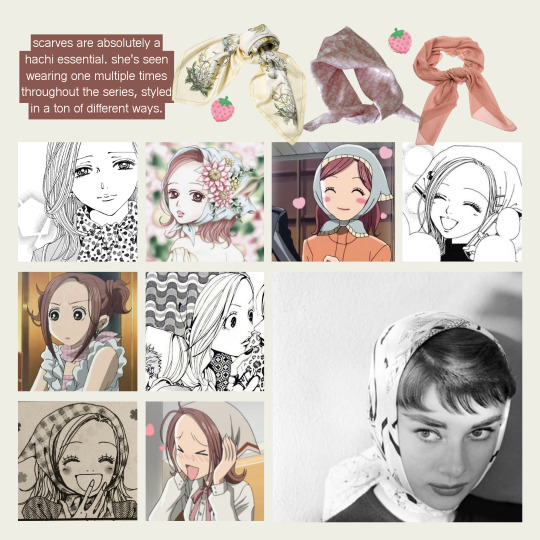
scarves and bandanas are a vintage essential as well as one of hachi's signature accessories. they have tons of versatile styling options, plus the potential to be dressed up or down. we've seen her wearing one scarf (exhibit A) multiple times over the series. the babushka scarf version has to be my favourite, it's very hepburn-esque, who i 100% i could picture hachi having a poster of in her childhood bedroom. i also think that having characters re-wear pieces we've seen before is generally just a cool subtle styling detail, which adds to the realism of NANA's 10/10 worldbuilding. the scarf's many appearances styled in different ways also goes to show how hachi enjoys being creative with her outfits, loves the pieces she owns and wants to get as much use out of them as possible.
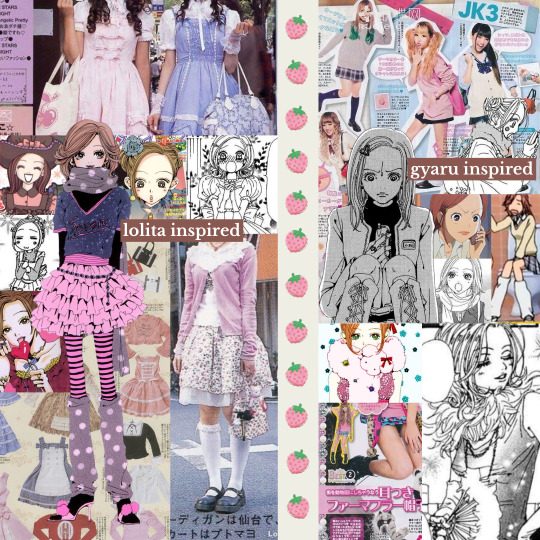
hachi's style also incorporates a touch of influence from the kawaii lolita subculture, particularly modern offshoots like larme-kei. lolita is french rococco-inspired with a focus on cuteness, and has its origins in early 2000s harajuku street style- which is also where mori/kogyaru fashion originates from; hachi's go-to style during her high school years (see: her modified school uniform, miniskirts, fuzzy legwarmers). both of these movements were heavily pioneered by j-fashion magazines of the time like FRUITS, Olive, Larme & CUTiE, which were mainly popular with teenage girls and young women, and hachi is no exception. her fashion sense is also heavily inspired by famous japanese celebrities and style icons like risa nakamura.
if we had to really narrow it down, i think hachi's style can be best described by otome (lit: maiden) fashion. known as one of the predecessors of lolita fashion, this style was very popular among young girls in the 70s-80s and is heavily centered around embodying all things traditionally feminine. sweet, cute, girly, and romantic are all common descriptors of the style, which pulls influence from 60s mod fashion (which, as we've seen, has prevalent elements in hachi's style). think tons of layering, pattern mixing, longer hemlines, and mary janes/flats, all of which we frequently see in hachi's outfits. we also see that she takes elements from modern lolita fashion like frills, bows, ribbons, lace, tights & stockings, and incorporates them into her own personal style as more understated outfit details; making it more wearable on a daily basis while still being a tribute to one of her sources of style inspiration.
now that we've explored what makes hachi's personal style unique to her character, let's dig into how her style is influenced in relation to how the story progresses and how her character develops. and just for funsies, i'll also be styling a casual everyday outfit that i could picture hachi wearing for each story arc. let's go!
🍓
i. art school
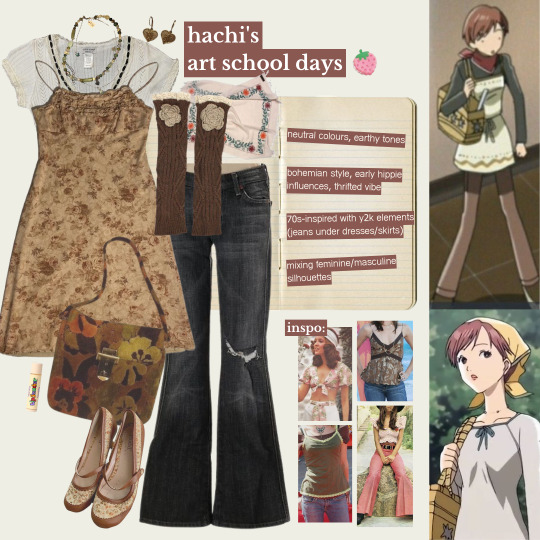
i'd describe hachi's style here as the most youthful, which makes sense considering she's freshly moved to tokyo to study at an art school. we see her sporting a face-framing pixie cut, which gives her look a bit of edge, but not too much as she still retains her signature soft girl style to balance it out. also, can i just say: super farmer's daughter vibes when paired with a bandana! jeans were having a moment too- during this era, hachi was often seen wearing a pair of bellbottom flares or baggy jeans, creating a casual and easygoing look which really leaned into the artsy college student fashion. this would also mesh well with her then-best friend junko's more bohemian/indie, woodstock-inspired hippie style. the short hair paired with her experimentation on androgynous silhouettes definitely accentuates her gamine facial features, lending to a cute boyish look.
all these style elements are in direct contrast with the hyperfeminine looks of her high school years, back when she'd opt for skirts over jeans and long, styled hair; showing how hachi underwent a pretty drastic style change whilst adapting to the new environment in tokyo. at the same time, it could also hint at hachi's approach to self-expression & using fashion as a coping mechanism to deal with major life changes. dressing more casually to blend in with the college crowd is one of many indicators on how easily influenced hachi can get, which is pretty on-brand behaviour for someone with a tendency to seek validation from others instead of oneself.
so let's get into the first look i've picked out for her: layers on layers on layers baby! for this outfit, i took a lot of inspiration from hachi's first day of class outfit. i tried to be consistent with her theme of 70s-inspired prints and silhouettes during this phase, but also wanted to incorporate a modern y2k touch since we know that younger hachi (before fully developing her unique & personal sense of style) is more of a trend chaser, and what could be more early 2000s than a blouse + dress + jeans combo? accessories-wise, i wanted to pick out unique-looking pieces that had a lot of charm, as i was really going for that 'flea market finds' vibe since she obviously wouldn't have been able to afford any designer yet on a college student budget. also please notice the gorgeous vintage floral print ballet flats- i was so excited when i found it, i thought it screamed hachi!! they look so comfortable to walk in on top of being cute, it's the perfect shoe to slip on for a long day of classes without sacrificing style.
🍓
ii. apartment 707

during this time, we see hachi start to embrace feminine styles again. she lets her hair grow out and we see her back in skirts, dresses, and all things girly, which is why her otome fashion influences shine through most here. she wears tons of pieces in floral and polkadot print, as well as flowy babydoll tops which are very y2k-girl-next-door-reminiscient. we also see her starting to wear vivienne jewelry (the pearl choker, the dainty silver orb earrings), likely as a result of nana's influence (who she heavily admires and looks up to) & wanting to emulate her style. hachi's outfits here seem to have more colour and print, which i believe is reflective of her mental state here; happy, confident, and surrounded by support. good vibes all around, her environment at this time encourages her to take more risks in not just decision-making but also in her fashion choices.
in general, this era is where hachi seems to be getting a better hold on growing into her own personal style. she's still open to trying out different styles every now and then, but we can see there are some style elements that really stick and appear most often in her outfits. she's also seen here experimenting with all kinds of different hairstyles- french braids, pigtails, twin buns, the half-updo. to me, i think all of this signifies how hachi's style development runs parallel to her identity formation and how she grows as a person. at this point of the story, hachi believes she's finally found a place where she fits- within this ragtag but loving cast of unique characters.
so the second look was a little more of a challenge to work with- that's because hachi's style during this era doesn't subscribe to any one specific aesthetic or subculture, but more like a bit of everything, and her outfits can differ a lot between episodes. the goal here was to go for a casual daytime outfit, and i ended up super proud of the colour coordination in this one! i've styled hachi in a frilly vintage floral print chiffon slip dress that's almost reminiscent of the strawberry dress of 2020, but with unique details that give it much more character. i gave hachi a cream-toned vivienne crossbody purse, a scarf to balance out the salmon pink of the dress accents, styled as a neckerchief, some strawberry hair clips to match, and of course i had to include her much-spotted pearl orb necklace too. the highlight of this look are definitely the shoes, which are maison margiela tabi ballet flats- something i could 100% picture hachi wearing if NANA were set in the context of modern day fashion trends.
🍓
iii. motherhood
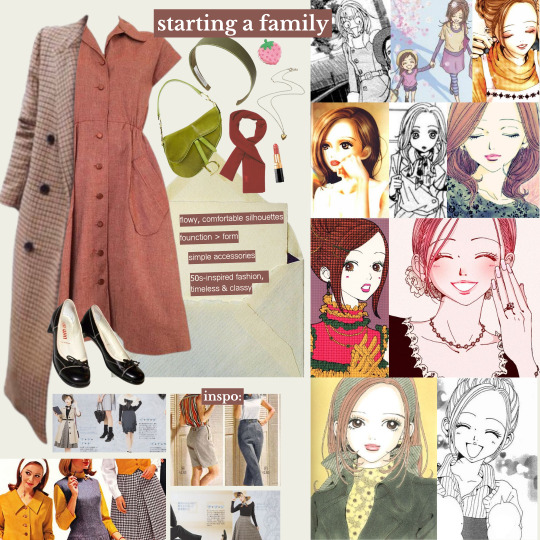
as time passes, we also see how hachi's fashion sense has slightly evolved into a classier, more refined version. more adult, if you will. this occurs when hachi decides to move out from apartment 707 and starts getting serious with takumi. not only did her living situation change, but as did her lifestyle, and with that, her fashion sense too. her style here simplified and took on a more mature look. she started prioritizing function over form as she cut down on layering and accessorizing. she would also opt for longer, flowier silhouettes and comfortable styles, often wearing simple dresses or aprons over a basic shirt-skirt combo. i really like how the change in style here - which pulls a lot from the 50s-suburbia housewife trope (think frilly aprons, puffy dresses, flared skirts, modest hemlines) - feels like a sublte detail to show how hachi settles into her new role of motherhood, expressed via clothing choices.
as a whole, this period of her life signifies the drastic 180° change from spending carefree days of young adulthood, to taking on the role of mother/wife in a nuclear family unit. it's the most major life change she's ever had to experience at this point, and it's expected that her style evolves alongside this. she's seen wearing noticeably less patterns or colour during this time, which could hint at possibly representing her inner feelings- the bleakness of spending her days in a mostly-empty home, and the isolation of being separated from the friendships she once surrounded herself with daily. thankfully, we do eventually see her return to dressing fashionably again after the timeskip. however, it's extremely important not to gloss over this period of her life as it portrays how she must have felt having most of her agency taken away overnight, with her style being all she had left as a form of control.
so last but not least is the final outfit, which was tough styling as there was comparably less material to go off, but i based it on the few going-out looks we get to see hachi wear post-takumi. rolling with the 50s-inspired looks, i've styled her in a coral short-sleeve button down dress. for the outerwear i picked a long checkered overcoat, which nicely complements the dress in addition to being a going-out staple for classy ladies everywhere. since the outfit is mostly harsher silhouettes, i decided to keep the colour scheme light to balance it out. while i was going for 'stylish mature woman', i still wanted some youthful elements in there to maintain hachi's signature girlish look. i balanced it out by accessorizing with a headband (a prep chic essential) and dior saddle bag, both lime green for a pop of colour and contrast. and of course, i had to incorporate the iconic neckerchief too as it doesn't get any more vintage-looking than this. the final piece to tie it all together are a pair of classic miu miu ballet flats- chic and comfortable!
🍓
final thoughts
all in all, hachi's fashion sense is super girly and sweet, which i'd say directly reflects on her character's personality. hachi is an outgoing girl who wears her heart on her sleeve and has a lot of love to give. she's warm and approachable, which she expresses through her clothing choices by embodying the cheerful, down-to-earth girl next door look. her bubbly style is youthful and fresh, which personality-wise is in character with hachi's innocence and willingness to trust others. this is shown through how much hachi cares deeply about her loved ones & often (unhealthily) prioritizes their feelings over her own. however, this naïveté unfortunately leaves her a lot more vulnerable to others seeking to exploit her emotional attention.
hachi's fashion evolution over the series shows how she uses fashion as a coping tool to help adjust to life changes, capturing her emotional growth and how she matures over the course of the story. the way that hachi's sense of style develops alongside her character is so realistic. her style development tells the story of a girl who finds herself and loses herself over and over again, frequently changing jobs and wardrobes in a constant struggle to find an identity to latch onto- until she does. hachi's style story is one of self-expression & identity formation; a story that speaks to all the young, unsure girls out there who see a bit of themselves in her, trying to figure out their place in a world in a world that often decides for them.
#oc#nana#nana manga#nana anime#nana komatsu#nana hachi#ai yazawa#collage#collage art#digital collage#fashion collage#fashion moodboard#style analysis#fashion analysis#character analysis#anime style analysis#essay#fashion essay#coquette#jfashion#harajuku#kawaii#pastel
1K notes
·
View notes
Text
youtube
Why are Modern High Heels so Bad? (Nicole Rudolph)
#wasteless crafts#video#video essay#youtube#nicole rudolph#subtitles#subtitled video#fashion#historical fashion#shoes#footwear#Youtube
454 notes
·
View notes
Text

nobody talks about the fact that blue was in fact bullied for being a psychic’s daughter and i think that’s probably why she has this defense mecanism where she appears more tough than she actually is .. ? idk i just love blue sargent so much man and im sick when people dismiss her character or reduce her to the boys bc she’s so much MORE than that
#the raven cycle#blue sargent#trc#blue sargent is my goal in life tbh#she’s so strong and so cool and has this part of sensibility too and and#her relationship with maura has my heart btw#i could do an essay on why blue sargent is so interesting and her character is so deep#like she is reduced to being the psychic’s daughter even though she is not herself a psychic so she has to express herself in other ways#like fashion#and she just wants something more bc she has so much to give and no one to give it to#until she met the boys#and she has a purpose now with glendower and everything that makes her feel useful in a different way that she is useful to his family#im rereading btw and going crazy as you may see
69 notes
·
View notes
Text
I think the theme of "home", while not always in the forefront, is something that interests me about the Sonic Movie Universe (in a similar way it interested me during Prime)
For Movie!Sonic, home is where you make it first and where your family is second. After his guardian died, he presumably jumped from place to place, and it was a while before he had a stable home. He made himself a home on earth and fell in love with the land and the culture. But you get the sense that as long as he's in hiding and ostracized all the time, it never fully feels like home. So it's important that he got to really experience earth and living in Movie 1 with Tom. It's important that he made earth his home, and then made the Wachowski household his base. No matter where he goes on earth and beyond, he has a family he chose and who chose him he can come back to and be himself around. "Home" for Movie!Sonic began with necessity, progressed due to his growing attachment to earth and what it offers, and fully settled in with him having a more permanent place in this world and support.
For Movie Tails, I surmise that "home" to him is where Sonic is. He was ostracized (possibly even bullied/picked on) back home for his two tails. After listening to some of his lines in movie 2, Tails read to me like a character who'd been treated as weird or an outcast and ended up isolating himself as a result. I got the impression that when he wasn't indulging in his love of technology/mechanics (or perhaps even at the same time) he was holed up in his base, watching a live stream of Sonic and his adventures, even after the conclusion of the first movie's events. He knows everything about Sonic, down to knowing that he doesn’t take showers, before even meeting him properly. Tails is not at home on earth nor particularly entranced by earth itself (in opposition to Sonic, who became entranced with it). He only even goes there to warn Sonic and to help him out. But Sonic's place—Sonic's home—is on Earth, in Green Hills, with Tom and Maddie, and Tails has formed an actual bond of friendship with the hedgehog he formed a possibly parasocial relationship with used to watch on a screen. Before, I think Tails was just content with watching or being helpful. But now? Now that he's spent time with Sonic, Sonic makes him feel normal. Sonic makes him feel like even "weirdos" can do great things. Sonic makes him feel valued. He's no longer content just watching because Sonic is more his home than the place he grew up in ever was. Home to him is with the people you choose, the people who make you feel at home, the people you want to be around. The Wachowski household is Sonic's home because he loves earth, green hills, and because he has mutually taken Tom and Maddie as his parents. Earth and the Wachowski household are only Tails' home as long as Sonic is there.
And for Knuckles... He has the set up to fall in love with earth in a similar way Sonic did. He grew up/was born in a similar place to him. And yet, all of the beautiful nature on earth doesn't matter to him. Knuckles, as of the beginning of the Knuckles series, had adopted a different approach to Sonic. Sonic tried to make home for himself wherever he could, no matter how many worlds he'd jumped to. In contrast, Knuckles never bothered to do this. He only pursued the mission, never bothering to make a home when he'd be off to the next world soon enough (especially if it seemed trivial in the face of his life's mission). And it's pointed that although he's able to participate in what earth offers the same way Sonic is in movie 1 (Knuckles learning how to bowl or Sonic going to a bar), he is not at home because of those things. He's able to slow down and appreciate what earth offers, the same things he couldn't bring himself to acknowledge before, and yet he's not at home on earth because it's beautiful or because it has food he likes or whatever. He very pointedly makes a connection with Wade and his family. The Whipple family is home. Not the earth, not even the house itself. He feels comfortable when with them, he enjoys the time on earth he spends with them, and he is able to appreciate Earth better when he experiences it with them (in contrast to Tails, who never had any sort of arc of appreciating what one can experience on earth to me). Home to Knuckles isn't easily quantifiable (more of a feeling really), but it’s about the people who make you feel at home. It's about the people who helped him relax and feel more comfortable not always putting his focus into the mission.
Sonic, who can make home anywhere, who always appreciated what was great about living on earth, and whose "home" was finally made permanent when he spent time with Tom and Maddie.
Tails, who never truly felt home until he spent time with Sonic, who doesn't particularly care for what earth has to offer, whose home is wherever Sonic is.
Knuckles, who never allowed himself to feel at home or tried to make a home until he began to travel with Wade and open up to new experiences, who began to enjoy earth and yet considers his home with the Whipple family specifically.
Sonic would protect the earth he lives on even if everyone he cared about was gone. Tails would protect the earth he lives on so long as it's Sonic's home. Knuckles would protect the world he lives on not just to keep the master emerald secured, but so long as this place is home to the Whipple family, with whom he enjoys experiencing Earth with.
Do you... Do you get me?
#sonic the hedgehog#knuckles the echidna#tails the fox#miles tails prower#unbreakable bond#sontails#sonic wachowski#knuckles whipple#knuckles series#sonic movie#knuckles 2024#sonic movie 2#knuckles series spoilers#knuckles 2024 spoilers#i just be ramblin#essay time#Sorry I'm just consumed with thoughts I'm emotional#it gets to me that what home is to Knuckles' borrows both from Sonic and Tails' experiences in different ways#And yeah while I do feel like saying 'Knuckles' home is the whipple family' is a bit eh reductive or a copout in a way‚ in the end I enjoy#that they are his home‚ but not in the same way the Wachowskis are to Sonic while not fully in the way Sonic is to Tails#Although all in all I actually am against the idea that Knuckles is in a nuclear family situation with the Whipples in a similar way I'm#against Tails's home with Sonic being reduced to 'so sibling behavior haha'#and with that being said‚ I tagged that one ship only to make it clear that I do not mean the Tails bit in a sibling way#But at the same time I am also not reducing Tails' home to romance either. It's more atypical or queerplatonic. Not siblings but not simply#just romantic but not necessarily solidly platonic. That's my stance. My other stance is that sontails fans should also be allowed to have#fun with the idea of movie Tails' arc and specific actions being interpreted in a romantic fashion😂#Anyways yeah
30 notes
·
View notes
Text
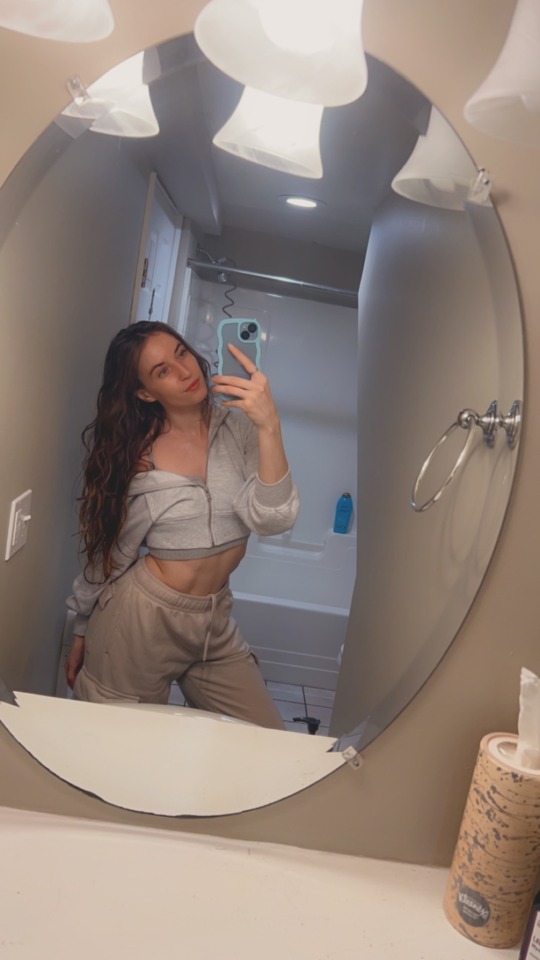

Mirror selfies to show you how long my hair is getting 🥰✨
#me#cute#girl#love#selfie#fashion#photo#brown hair#blue eyes#hot#tumblr#I’m procrastinating finishing my essay#someone bully me nicely into finishing my essay please it’s half done but I have no motivation#I’m comparing the heart of a doggo and a bird#it’s a cool topic but my brain is tired#also I’m extremely happy that it is sweat pants season#also update on the aquarium day!#I’m going on Monday and then I’m treating myself to going to a new Barnes and Noble#I shall maybe buy a book!#I’m hoping to find some nerd shit#nerd shit being a cool book on an animal or anything vet medicine related#also my hair is getting so long I didn’t even realize till the other day
65 notes
·
View notes
Text
Essay on the relationship between goth and grunge
Goth is a music based subculture created in the 80s. Pioneered by bands such as Bauhaus, Siouxsie and the Banshees and The Cure, it is a subculture with a convoluted history and tumultuous developments. Its aesthetic, sonic and lifestyle components being influenced primarily by horror films, avant garde art, music, cinema and literature, campy b movies, glam rock, punk, old Hollywood and classic literature, it has been among the most surviving counterculture amongst others of the same era, especially among teens and adults. It has survived, and continues to struggle against, numerous misconceptions and stereotypes by the media, perverted men and posers deliberately warping the scene to their advantage due to the efforts of those among the scene. It has clearly defined values and characteristics of those who choose to participate in the scene, that revolve around clubbing, social participation, seeing and being seen, political and cultural conscientiousness, creativity, insular tastes in media and hobbies and overall can be seen as a means of self help and building of one’s identity.
Grunge, on the other hand, at first seems the radical opposite.
Grunge, also a music based subculture, was created in Seattle in the 90s, although there is evidence to support that grunge type sounds have been around prior to the 90s in the form of bands such as Flipper and Green River. Nevertheless, grunge was popularized by bands such as Nirvana, Pearl Jam, Soundgarden and Alice In Chains, becoming huge throughout the beginning to the middle of the decade. Amongst the members of Gen X who participated in the scene, the unfashion and sonic elements of grunge was influenced by feelings of directionless and lack of hope for the future, as the workforce at the time was still dominated by boomers who refused to leave space for Gen X. These historical components can be seen the deliberately slovenly fashion of grunge adherents in the form of flannel shirts, t shirts and ripped jeans, many Nirvana lyrics being purposely directionless to represent such feelings by Kurt Cobain, and an overall reclaiming of the stigma of poverty to combat the material excessiveness of the 80s. Grunge, as a sound, varies from the punk sounds of Mudhoney, alternative rock such as Nirvana, sludgy metal in the form of The Melvins, Soundgarden and Alice In Chains to an evenly sounded Mother Love Bone, but can be best described as a mix between Punk and Metal.
According to many goths and punks around at grunge’s rise to popularity, grunge was an especially disliked scene, due to the punks feelings of many grunge kids being the same individuals who bullied and ostracized the alternative crowd of the 80s, and would have done the same to Kurt Cobain had he never became famous, along with many goths and punks disliking the toxic masculinity displayed by grunge adherents in fashion and behavior, especially in regards to many hair metal bands going in a grunge direction.
Grunge has been documented and dissected, much to the dismay of those involved, since the beginning. The most famous example of this phenomenon is Marc Jacobs Perry Ellis fashion “grunge” runway of 1992-1993, reportedly so disliked it was burned by Kurt Cobain and Courtney Love, along with causing Jacobs to be fired by Perry Ellis, due to an increasing concern of the commercialization of grunge that it never really recovered from to this day, another stark contrast it has from goth. If you look up grunge now on the internet, you will find a warped idea of grunge in the form of expensive fast fashion brands and clothing, Instagram accounts featuring hyper sexualized depictions of vaguely alternative women and the remaining devotees of true grunge culture in the form of old men and young people alike on the internet posting of bands like Nirvana.
At first glance, especially looking at the masculine sides of grunge, that goth and grunge are inherently incompatible, and due to grunge’s popularity eating at the goth scenes previous dominance in youth culture of yesteryear. But, I would like to offer a different argument from an angle no one has quite considered. The feminine elements of grunge.
Kinderwhore, is a variant of grunge fashion worn by women in grunge bands and within grunge scenes that was created by Kat Bjelland of Babes in Toyland and popularized by Courtney Love.
Where exactly Kinderwhore gets its name is from journalist Everett True, during an interview with Kurt Cobain and Courtney love. The fashion revolves around purposely inflating traditional, girlish fashions to cartoonish levels, and then subverting them via aggressive, masculine behavior to avoid potential insecurities. Meaning, many women in grunge bands who dressed kinderwhore would always be as aggressive on stage as the men, oftentimes singing feminist lyrics.
The fashion itself revolves around babydoll dresses, slip dresses and Mary janes or combat boots, along with ripped tights, chokers, leather jackets, cardigans and dresses with lace details or Peter Pan collars.
Kinderwhore is related to riot grrl, which is a subset of punk that was underground in the 90s in contrast to grunge, but some within the grunge scene, especially Courtney Love, rejected and denied her work being riot grrl in the first place. If one sees riot grrls middle class origins, white feminism, exclusionary behavior towards trans women, and superficial lyrical and social attitudes, it’s easy to see why many within punk and grunge scenes would want to distance themselves from it. That being said, riot grrls only contribution worth noting to punk was it’s push towards inclusiveness to women due to punk growing increasingly misogynistic and unsafe for women in the 80s, and its efforts have done the most to make punk a better space for women.
What attracts many goths to goth fashion is a deliberate subversion of gender and gender roles in the form of its visuals. Many goths, men and women, would both wear makeup and dress masculine or feminine as they desired, especially due to goth’s acceptance of those deemed “different” by broader society. With keeping in mind to Kinderwhore, a fashion style that also revolves around subverting gender expectations, it is to be expected that among women of goth and grunge, a meeting was destined to take place. Among the women of 90s goth, it was common for them to combine goth fashion with kinderwhore looks.
In the 90s new wave bands such as Strawberry Switchblade, and deathrock bands such as Cinema Strange have experimented with Kindergoth (kinderwhore + goth) looks, that ultimately led designers such as Anna Sui sending her team to scout goth clubs to take inspiration for designs for future garments that would oftentimes be out of reach for many goths due to lack of affordability for the working class individuals in the scene.
With all these examples in terms of visuals, goth and grunge inspired looks is a feasible venture provided it is put under feminine lenses. Many attempts have been made by those who understand neither scene to create a “grunge goth” hybrid, as seen in many online accounts and opportunistic business ventures by outsiders, but a true grunge goth fusion would combine goth fashion with the ever subversive kinderwhore fashion, its legacy seen in many online aesthetics including the Morute aesthetic, a sister aesthetic subculture used primarily as a means of coping with childhood trauma via the means of girlish femininity combined with grunge and American gothic encapsulated by the works of Nicole Dollanganger and an assortment of women photographers on tumblr and beyond.
Sonically, there can be a case for similarities between goth and grunge. Both use a distorted bass, use vocals that howl and scream and punk like guitars. With these similarities in mind, I believe it is feasible for a grunge/deathrock hybrid band to exist, but as of this writing I cannot find a band that has done this. Perhaps some day.
Sources:
Some wear leather some wear lace by Andi Harriman
https://youtu.be/peEUXhCY8lY by Angela Benedict and the comments cited
My dad, a true grunger :)
Various accounts from old punks on Reddit on r/punk
Marc Jacobs’s Perry Ellis Grunge Show: The Collection That Sent a Electric Shock Through '90s Fashion | Vogue

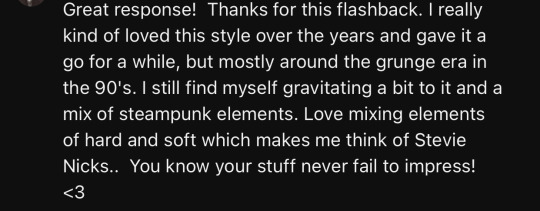


#mine#my essays#new year new motivation to actually post essays#essay#gothgoth#90s grunge#grunge#kinderwhore#morute#goth music#goth fashion#grunge fashion#cultural studies#feminism#anarchopunk#punk culture#punk#kindergoth#fashion history#90s fashion#alternative fashion#music history#grunge music
324 notes
·
View notes
Text
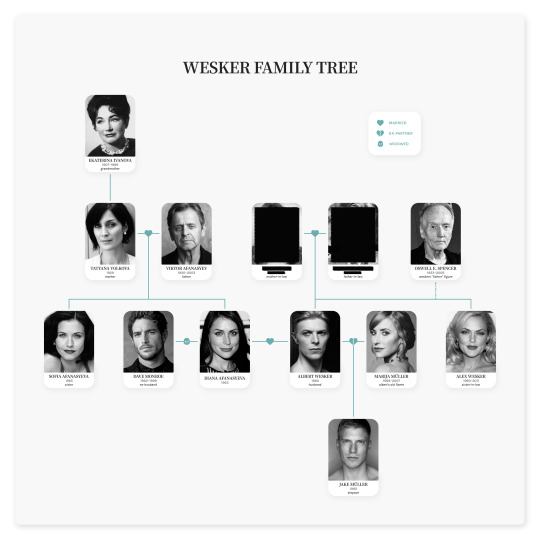
RESIDENT EVIL → THE WESKER FAMILY
To the public, little is known of the families behind some of the world’s most renowned bioterrorists, but the question remains: did they play a role in causing their children to walk down the path that they did? Or are these individuals simply ambitious criminals with delusions of grandeur?

For Diana Wesker (née Afanasyeva), her introduction into the bioweapons black market trade was upon discovering her employers were using her research into limb regeneration with salamanders to further their experiments in creating enhanced soldiers, instead of developing human therapies with which she was recruited for. Although the prospect of using biological weapons in the military did not appeal to her, the concept remained fascinating for her own selfish endeavours. Born on the 27th of October, 1963 in Sydney, Australia to Russian immigrant parents, Diana had harsh expectations placed upon her at a young age, ones that no matter how hard she tried she could never live up to. Her mother, Tatyana, was an unfeeling woman, absent for long stretches of time with little regard to how it affected her daughters, much more concerned with her craft as an accomplished opera singer. Viktor was no better. A strict man whose role as father and ballet master blurred, he pushed his girls to one day follow in his footsteps. Whilst Sofia enjoyed ballet, and went on to become a professional ballet dancer, Diana’s heart was set on going into the field of biology. She wished to make a name for herself, separate from her family – to which she succeeded.
Diana was married to former U.S. Marine, Dave Monroe, for only a year until he was declared dead in 1992 after succumbing to injuries sustained in a horrific car accident. Foul play was ruled out while Diana played the role of the grief-stricken widow, but in reality, she had snapped after years of mistreatment at her husband’s hands, and opted for something she could pass off as an accident to be free of him. For years she believed he was dead – and he was, legally – but that proved to not be the case when he found his way back into her life again in 1999. Unbeknownst to her, she had been lied to by the police and coroner, who were paid off by her employers when they took Dave’s body for themselves and used him as one of their first test subjects in developing supersoldiers. Before he could ever hurt her again, Diana’s second husband, Albert Wesker, tracked the man down, captured him and tortured him, before allowing Diana to get her violent and bloody revenge.
The origins of Albert Wesker’s involvement in bioterrorism, alongside his twin sister, Alex, are much different than that of Diana’s. The two hail from London, Canada, but unfortunately, they hold no memories of their lives there, nor what happened to their biological parents when they were eight years old. Agents of Oswell E. Spencer, an aristocratic billionaire and eugenicist, took the twins from their home and executed their parents as per Spencer’s orders. Albert and Alex were then placed in a home funded by the Spencer Foundation where they were given new names and a privileged upbringing. They had access to the best education possible, free to pursue whichever field they decided, but it was by no accident they both went into virology and bioengineering; at home, their adoptive parents – agents whom they believed to be their real parents – instilled them with the beliefs of Oswell E. Spencer, harbouring disdain for war and pestilence, and believing humans to be an evolutionary dead-end in need of a rebirth. They were only two of the hundreds of children “adopted” as part of what is known as Project W, a plan intended to develop an advanced race of human beings. The most promising candidates were headhunted by Umbrella Pharmaceuticals, the twins amongst them, where they went on to create bioweapons for the company founded by none other than the man who had handpicked them for his plan. The final stage of this was to infect the thirteen Spencer saw fit, however, only two survived; Albert received the intended effects, now possessing superhuman abilities, however, Alex was only offered more time to live due to her terminal degenerative illness.
In the summer of 1995, Diana was working undercover within Umbrella to gather development data on their projects for her company. Here, she had a chance encounter with Albert, an intelligence officer at the time, which permanently altered the course of her life. The two were never seen far from one another’s side, marrying in 1998, and they went on to become notorious in the bioweapons industry. The development of the Uroboros virus was where things took a turn for the worst. Although Diana’s infection was successful and she bore abilities that rivalled her husband’s, the plan itself did not succeed as they had hoped, and almost cost Albert his life at the hands of his former subordinates.
Now, they work within the shadows, with Diana declared missing and Albert believed to be dead. Their legacy, however, lives on with the mark they left on the world. As visionaries in their field, they influenced bioterror attacks carried out by countless individuals and organisations. In turn, they also inspired others to fight against such atrocities. One such person happens to be Albert’s son from a former relationship, Jake Müller, whose existence he was unaware of.

#mine.#oc: diana#pair: ewskers#click for better quality cause it's large & tumblr ate it ♡#hii so happy birthday diana !! queen is 60 today :]#um. there's no template cause i made this from scratch...i couldn't find any i was vibing with so i was like you know what lmaoo#i'm sorry for the essay...it was meant to be just a short rundown of the family but well...that happened. typical leah fashion...#oh and guys. did you know that there's a limit to the amount you can put in one blockquote? that's why the rest is just left like that caus#i didn't like how it looked with a blockquote each paragraph...cause the spaces between were unever. you understand 😔#with the tree i was also going to include weskids adoptive parents but i couldn't figure out how to arrange it all & make it look nice !!#cause i also wanted to have spencer in there as well cause he's a big reason why the weskids are the way they are...was maybe gonna include#sherry as well. like connected to jake (hehe) and then do her parents too but that would've made things so wide & it's already big enough#yes. i hc that albert & alex are biological twins. just for clarification there :] i don't think i added anything else that isn't canon or#implied with canon. cause the weskids were put in homes (or at least whatever ''controlled environments'' means) where they were monitored#by umbrella but were unaware of it. so yeah. i don't think i really changed much there !!#honestly i could've kept rambling cause there's alex's whole situation. there's my lore with jake's mum. there's way more with the ewskers#but it's already so long & i can't be concise so there's that lmaoo oh also diana's grandma. so much stuff#also meant to say the weskids birthday in that ramble. it's january 15 1960 :] they are capricorn sun leo moons but alex was born earlier s#their rising signs are albert is a scorpio rising & alex is a libra rising !!#had to redo the image cause typo on diana's birth year for some reason lmao so if that messed up the formatting i will sob
53 notes
·
View notes
Text
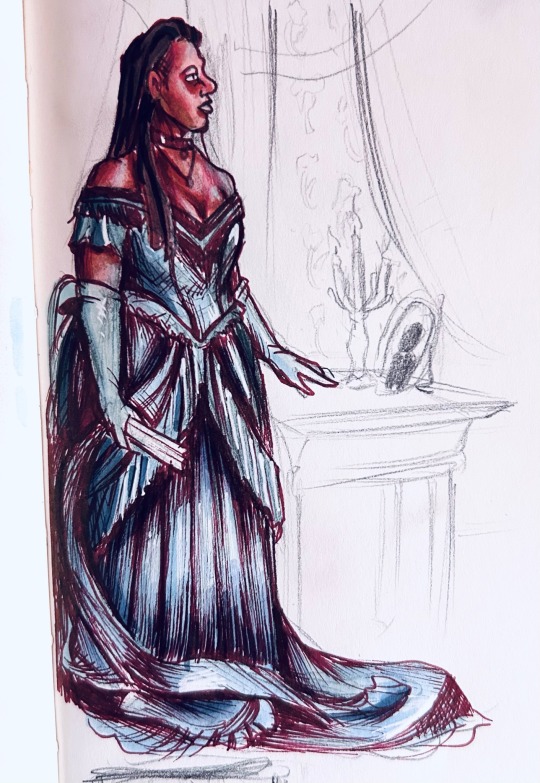
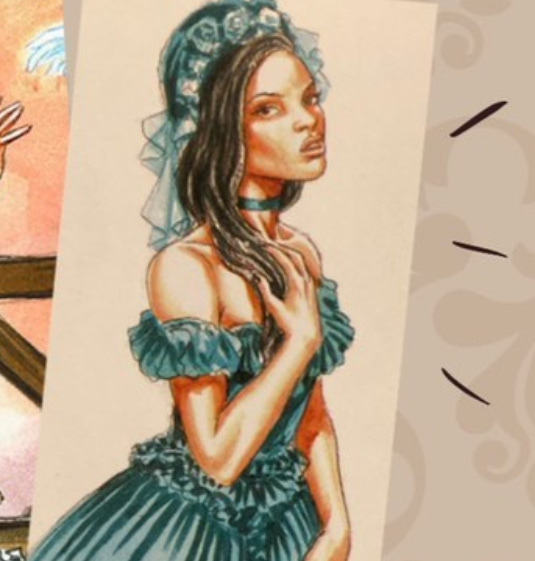
Based off of that one drawing on the character design page of the Transitus earbook. Red ink and alcohol markers.
#ayreon#art#transitus#fanart#cammie beverly#oh what we could have had with Transitus costumes….#thinking about doing an essay one why the OG character designs kinda irk me#like its been a while since the comic was released#and I’ve gotten much better at articulating that my issues with it aren’t just rooted in historical accuracy for its own sake#idk maybe#ohuhu markers#ink art#1880s#historical fashion#gilded age#arjen lucassen#sketch
27 notes
·
View notes
Text
1880s: Dominique is very Masculine, and very Eccentric

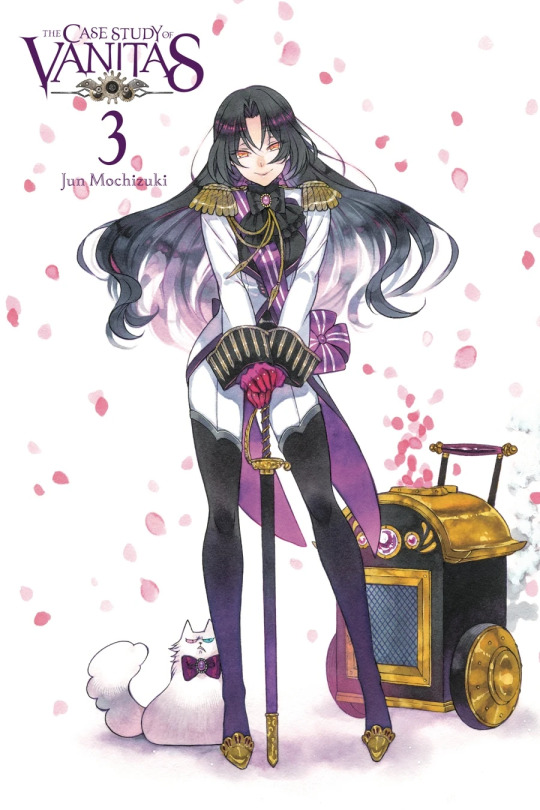
In today's standards, Dominique is a fairly feminine woman. Yes she's wearing a prince inspired outfit, but it's feminized with the tight pants, long stockings, heels, and long hair, but what if I told you that was all considered masculine in the olden days?

The Time Period
Givn the story takes place when the alternate Eiffel Tower (can't remember the name) was being built, we can assume vnc takes place in the late 19th century, otherwise known as the Victorian era, ranging from 1820 to 1914.
The fashion looked somewhat like this, you can see some similarities to the outfits worn by the main cast.

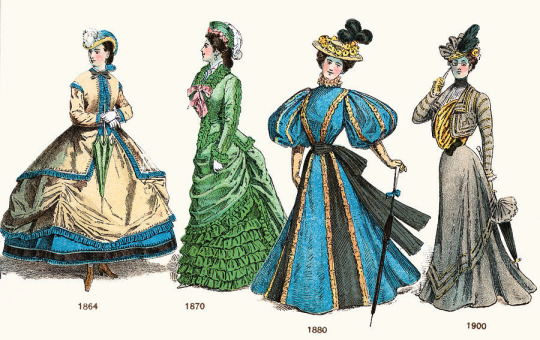
Dominique's outfit doesn't really resemble much of the fashion at the time, you can make som mild comparisons to Victorian royal menswear, but I'd say her fashion is more similar to 17th century royal menswear, specifically,
King Louis XIV
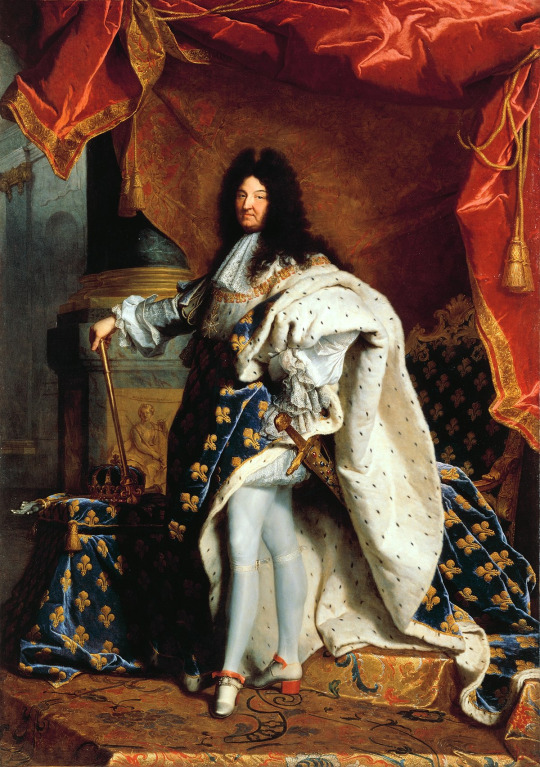
The long hair, the tight white bottoms, the heels, the loose sleeves, the train of fabric behind him, It is said that King Louis was a big womanizer, who does this all sound like? It's almost as if Dominique is trying to be Louis- oh wait.
Also fun fact, King Louis XIV was born in Saint-Germain-en-Laye.


Masculinity & Eccentricity
For us in the present, King Louis XIV looks pretty feminine, and that was probably a shared sentiment in the 19th century, he looked outdated, but that same outfit on a woman like Dominique would cause some controversy if not for her status.
In the 19th and early 20th century, a woman wearing pants was not too accepted, women usually wore dresses, and pants were kept as a sports/work attire. A woman would not just go on about her day wearing a pair of pants, she'd be seen as strange, and maybe even get into trouble. Dominique wearing pants, and very tight pants reminicscent of older eras, is definetly a bold choice.
Her hair is long and straight, which is not how you'd usually describe a victorian woman's hair. It wasn't even that much of a gender thing, but more of a formality thing. Women at the time would have their long hair in an updo. Actually, according to Whizzpast, long loose hair was a thing only models and actresses wore to depict romantisiscm and intimacy.
Dominique's long hair makes a lot of since, she has a bold, eccentric personality, she's not one to conform, she's the current family outcast, but she is also a very romantic person, and is constantly seen in romantic/intimate scenes, so her loose hair really depicts that.
All in all, Dominique's appearance states a bold, romantic blast to the past with a pinch of her desceased brother.
If you want to look into queer subtext, you can assume that''s one of the reasons Noe drinks her blood.
#damn this is the longest analysis/essay I've done in a while#vnc really makes me think#vnc#vanitas no carte#dominique#dominique de sade#french fashion#fashion history#anime#manga#the case study of vanitas
54 notes
·
View notes
Text
"Christian imagery is among the most controversial elements of Gothic subcultural style. Crucifixes, rosaries, crosses, angels, and images of Christ are juxtaposed with gargoyles, demons, vampires and satanic images to high affect. Likewise nun's habits and monk's robes may be worn with fishnets and garters, dog collars, chains, and heavy leathers. Though mainstream culture has often taken this imagery at face value and believed Goths to be Satanists, this is not the case. Blasphemy is used as a symbol of rebellion in much the same way that fascist imagery, such as the swastika, was used by the Punks. As forbidden, culturally maligned images they serve to shock, to identify the wearer with dangerous, powerful forces, and as a kind of cultural mirror - as if to say that what society fears and despises most is in fact the essence of itself. Like the omnipresent cross over the grave of the betrayed, 'undead' Giselle in the Romantic (Gothic) ballet of the same name, the ironic reference is a lot of good Christianity did her'."
Tricia Henry Young, Dancing on Bela Lugosi's Grave: The Politics and Aesthetics of Gothic Club Dancing, Dance Research: The Journal of the Society for Dance Research Vol. 17, No. 1 (Summer, 1999), pp. 75-97. Source.
#Tricia Henry Young#bela lugosi#goth#gothcore#goth aesthetic#gothgoth#romantic goth#trad goth#gothic#vampire goth#gothique#quotes#words#essay quote#subculture#goth fashion#christian imagery
246 notes
·
View notes
Text
Okay but that scene in Titanic where Rose decides you know what no I’m NOT going to guarantee my safety by staying in this lifeboat and she jumps back onto the ship and she and Jack immediately start SPRINTING to try and get to each other and when they finally do Jack kisses her all frantically and calls her stupid…that’s true love baby
#Okay so apparently I’m not done talking about Titanic (1997). Sorry#Little me was obsessed with this scene and adult me is NO different.#One day I will find someone who will rush down a flight of stairs to embrace me tightly#kiss me all over my face. And call me stupid#Can’t wait for it actually#Anyway I could go on and on about this scene. In this essay I will fashion.#But I won’t bc I need to go to bed lmao.#This scene will always be playing rent free in my head tho#‘Why’d you do that huh?!! You’re so stupid Rose!’#Me forever bitter that they killed Jack: This is fine#This is really embarrassing I’m so sorry. I can’t help it I love this stupid fuckign movie#Shima speaks
55 notes
·
View notes
Text
Found a new YouTube channel called The Financial Diet. Videos include:
"You're Not Ugly, You're Just Poor": A Deep Dive (watched)
How The Wealthy Gaslight America
It's Not Just You: Jobs Didn't Used To Be This Terrible (watched)
The Toxic Boomer Money Advice You Need To Unlearn (watched)
3 Lessons From My No-Buy Year That Totally Changed My Finances (watched)
3 Things I No Longer Buy After My No-Buy Year (watched)
4 Lies From The Beauty Industry That Trick You Into Spending More Money (watched)
4 Minimalist Principles I Practice After Quitting Shopping For 1 Year (watched)
Overcoming "Post-Traumatic Broke Syndrome" & Building Real Wealth (watched, features TheBudgetnista Tiffany Aliche who talks about the finances of grief, the lasting effects of being broke, and what it means to be truly good with money)
Why ADHD Makes Money So Hard (And What To Do About It)
#finance#the financial diet#no buy year#capitalism#body image#consumerism#online shopping#plastic surgery#retirement#cost of living#video essay recommendations#america#beauty standards#unlearning#financial advice#eat the rich#cosmetics#big pharma#makeup#fast fashion#shopping addiction#therapy#retail therapy#psychology#the budgetnista#Tiffany Aliche#adhd#neurodivergent#grief
10 notes
·
View notes
Text
the scene in epel's second birthday vignette where floyd gave him the watch absolutely ruined me btw. like ik not everybody headcanons epel as trans but as someone who does it just put such a fine point on his struggle with being seen as masculine, like a fancy wristwatch wouldnt particularly help him look strong enough to overcome his bullies or whatever its literally just. something a man would own. and he gets so overjoyed. because he consistently has to *prove* that he wants to be masculine despite his appearance; even more sensitive characters like deuce take a while to catch on to the fact, and then here he gets the watch as a gift & gets called handsome without asking for it. even though its a happy scene it fucked me up so bad 😭
#txt#THATS ANOTHER THING i think contributes to his starting to fit in at pomefiore that ppl rarely bring up bc its most clear in this specific#card's vignettes & homescreen lines: epel really does care about his appearance!! and we see him start to have more fun with it & experiment#with style more; but it doesn't come across during the main story when he's just in his school uniform that vil arranged for him#and like. if you had Only read the harveston event & the main story i can kinda see where the 'epel is innately okay with feminine stuff &#vil is right for suppressing his desire to be masculine!!' argument comes from#but like. even if his affinity for masculinity is at any point little more than a rejection of femininity. his budding interest in masculine#*fashion* shows that his desired gender presentation is its own fully formed thing and not just the absence/hatred of something else#ergo he fits pomefiores principles of beauty & pride#does this make any sense. tumblr tags are the worst place to write an essay
26 notes
·
View notes
Text

01. Impossible Germany by Wilco || 02. Port of Call by Beirut || 03. Short and Sweet by Brittany Howard || 04. Into The Red by James Blake ||05. Love Language by SZA || 06. Where's My Love by SYML || 07. Like A Star by Corinne Bailey Rae || 08. Tell Me You Love Me by Sufjan Stevens || 09. Coming Back by James Blake ft. SZA || 10. Couldn't Love You More by John Martyn || 11. Love and Happiness by Al Green || 12. Come Back by Pearl Jam
#sydcarmy#carmy x sydney#sydney x carmy#Decided to travel back in time and make an old-fashioned 8track style playlist for Sydcarmy. You know#edited cover picture#carefully selected 8 to 12 songs...#specific order...#that kind of thing.#I think I did it more for myself#for when I can't get them out of my head#but thought I could share in case someone wants to feel the same about these two!#sneaked in two important songs in the show... as a way to open the story and close it... temporarily ! !#i still have hope for the future#some songs even kind of dialogue between each other#as if some are more carmy and some more sydney... and they talk among each other... but im not telling which lol#but anywaysssss hope u enjoy it#music#Spotify#also took some songs from people that posted them in the tags! thanks for the inspiratioooon. everyone in the tag is great#i could write an essay on each song selection and the lyrics that hit the most regarding this two... but im trying to not be so extra for#now lol
33 notes
·
View notes